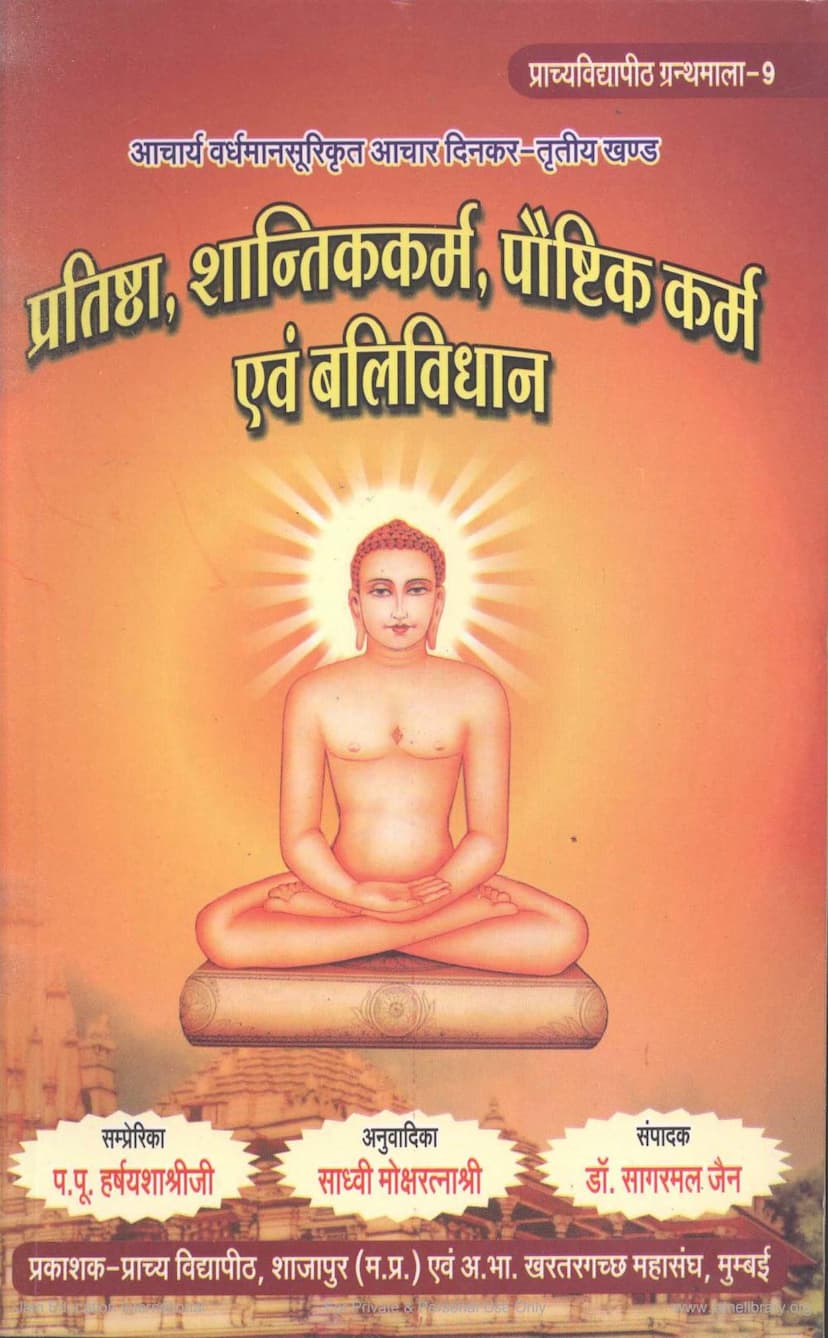Pratishtha Shantikkarma Paushtikkarma Evam Balividhan
Added to library: September 2, 2025

Summary
This Jain text, "Pratishtha Shantikkarma Paushtikkarma Evam Balividhan" (प्रतिष्ठा, शान्तिकर्म, पौष्टिककर्म एवं बलिविधान), is the third volume of "Acharadinkar" (आचारदिनकर), authored by Acharya Vardhmansuri (आचार्य वर्धमानसूरि) and edited by Dr. Sagarmal Jain (डॉ. सागरमल जैन). Published by Prachya Vidyapith Shajapur and Akhil Bharatiya Khartargachch Mahasangh, Mumbai, this work focuses on specific rituals and practices within the Jain tradition, particularly those associated with consecration, peace-making, prosperity, and offerings.
The book is a translation of the original Sanskrit and Prakrit text, undertaken by Sadhvi Moksharatnashri (साध्वी मोक्षरत्नाश्री), under the guidance of Dr. Sagarmal Jain and with the blessings of various revered ascetics. The translation is dedicated to the spiritual mentors of Sadhvi Moksharatnashri, highlighting her gratitude for their teachings and support in making this ancient knowledge accessible.
Key contents of this volume (and the broader "Acharadinkar"):
-
"Acharadinkar" (आचारदिनकर) itself is a comprehensive treatise by Acharya Vardhmansuri, covering the conduct and rituals for both householders and ascetics. The work is divided into four volumes:
- Volume I: Deals with the sixteen samskaras (rites of passage) for householders.
- Volume II: Focuses on the sixteen samskaras for Jain monks.
- Volume III (This Volume): Encompasses rituals related to Pratishtha (प्रतिष्ठा - consecration/installation), Shantikarma (शान्तिकर्म - rituals for peace and well-being), Paushtikkarma (पौष्टिककर्म - rituals for prosperity and nourishment), and Balividhan (बलि विधान - rituals of offerings). These are primarily concerned with ritualistic actions.
- Volume IV: Covers Prayashchitta Vidhi (प्रायश्चित्त विधि - penitential rites), Shadavasayaka Vidhi (षडावश्यक विधि - six essential duties), Tapa Vidhi (तप विधि - ascetic practices), and Padaropana Vidhi (पदारोपण विधि - installation to positions).
-
Content of Volume III (Pratishtha, Shantikarma, Paushtikkarma, and Balividhan):
- Pratishtha Vidhi (प्रतिष्ठा विधि): This extensive section details the intricate procedures for consecrating various entities. It outlines the significance of giving prominence or reverence to individuals or objects through specific rituals. The text elaborates on the consecration of:
- Jain idols (Jinbimba Pratishtha): Covering different materials like stone, wood, ivory, metal, and paintings, and for various settings like home shrines (Griha Chaitya) and temples (Chaitra). It provides detailed guidelines on the appropriate size, characteristics, and materials for idols, along with specific astrological considerations for consecration.
- Temples and related structures (Chaitra Pratishtha): Including consecration of the main temple, small shrines, pavilions, and chambers.
- Various ritualistic items: Such as Kalash (water pots), Dhwaj (flags), Bimba Parikara (ornaments around idols), Devi (goddesses like Ambika), Kshetrapal (guardian deities), Ganesh and other deities, Siddha Murtis (images of liberated souls), Mandala (sacred diagrams), Mantrapattas (inscribed plates), Pitru Murtis (ancestral images), Yati Murtis (images of ascetics), Griha (houses), Vaapi (step-wells), Vriksha (trees), Bhavana (buildings), Durg (forts), and Bhoomi (land).
- Astrological considerations: The text meticulously details the auspicious times, lunar constellations, planetary positions, and specific yogas required for successful consecration, including detailed explanations of auspicious and inauspicious planetary placements in the horoscope during the ceremony. It also provides guidance on observing purity, undertaking specific fasts, and performing rituals with devotion.
- Specific materials and procedures: The text lists numerous ingredients required for these rituals, such as various herbs, grains, metals, gems, and other materials for purification and offerings. It details the correct way to perform ablutions, apply fragrances, offer incense, light lamps, and present food.
- Mantras and invocations: The text incorporates numerous mantras and invocations for deities and presiding spirits, emphasizing the importance of correct pronunciation and devotion.
- Shantikarma (शान्तिकर्म): This section focuses on rituals aimed at bringing peace, removing obstacles, and ensuring well-being. It explains the importance of performing these rituals during times of distress, natural calamities, or when specific astrological afflictions are present. The procedures involve homa (fire offerings), chanting of peace mantras, and offerings to pacify planetary influences and malevolent forces.
- Paushtikkarma (पौष्टिककर्म): This section deals with rituals designed to promote prosperity, growth, and abundance. It includes practices to enhance wealth, health, family well-being, and agricultural success. These rituals often involve offerings and prayers for divine blessings.
- Balividhan (बलि विधान): This part describes the rituals of making offerings to deities, spirits, and benevolent forces. It details the types of offerings (food, drink, etc.) and the procedures for presenting them to different entities according to their specific preferences and the purpose of the ritual. It also touches upon appeasing spirits associated with specific locations or elements.
- Pratishtha Vidhi (प्रतिष्ठा विधि): This extensive section details the intricate procedures for consecrating various entities. It outlines the significance of giving prominence or reverence to individuals or objects through specific rituals. The text elaborates on the consecration of:
Significance and Context:
- Integration of Traditions: The text reflects the historical evolution of Jain ritualistic practices, showing influences from and adaptations of broader Indian traditions (like Vedic rituals) while maintaining a distinctly Jain philosophical and doctrinal framework. The author, Vardhmansuri, acknowledges drawing from both Shvetambar and Digambar traditions.
- Preservation of Ancient Practices: This translation plays a crucial role in making the complex and often obscure ritualistic knowledge of "Acharadinkar" accessible to a wider audience, especially householders and those interested in Jain ceremonies.
- Scholarly Effort: The involvement of Dr. Sagarmal Jain, a renowned scholar, and Sadhvi Moksharatnashri, a dedicated translator, highlights the scholarly rigor behind this publication, aiming for an accurate and comprehensible rendition of the original text.
- Comprehensive Nature: The detailed listing of ingredients, steps, mantras, and astrological considerations within the Pratishtha Vidhi demonstrates the meticulous nature of these ceremonies and their integration with cosmological beliefs.
In essence, "Pratishtha Shantikkarma Paushtikkarma Evam Balividhan" is a vital resource for understanding and practicing significant ritualistic aspects of Jainism, offering a bridge between ancient scriptural knowledge and contemporary practice through its scholarly translation and compilation.